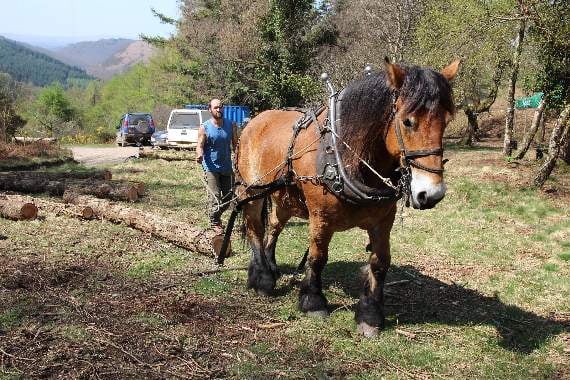LOCALS were able to see the progress of the first-ever archaeological excavation of an Iron Age fort deep in Fingle Woods on Saturday.
The open day at Wooston Castle took place on the final day of the two week-long dig, in the woods near Drewsteignton.
Staff and volunteers were on hand to give guided tours of the hillfort and trenches and the Dartmoor horse loggers, who helped clear trees from the site to allow the excavations to take place, gave demonstrations.
Volunteers from across Devon worked with professional archaeologists to excavate trenches on site, revealing more about how the fort on the slopes of the Teign Valley came to be built. In the course of the fortnight, they established that the fort was built in two stages – a simple circular structure first, followed later by a more elaborate hillfort.
Evidence of charcoal burning was also uncovered, with samples to be carbon dated, along with soil samples which may hold the clue to what was growing on the land back in the centuries before the Roman invasion of Britain in 43AD.
‘A really key thing for us was the community engagement aspect, and for me that was the most rewarding part of it, seeing how excited everyone was about it,’ said Eleanor Lewis, community engagement officer for Fingle Woods, which is owned and managed jointly by the National Trust and the Woodland Trust.
‘We were lucky enough to be overwhelmed by applications from people who wanted to volunteer. We had an incredible team who worked alongside the professionals.
‘At the beginning of the fortnight, the archaeologists were concerned that we weren’t going to get it done, but the volunteers worked so hard that we got from the edge of the first trench by the end of the first week.
‘It was the first time this hill fort had been excavated, and the first excavation in the area for nearly a decade. Hillforts are so protected by law, they are very rarely excavated and we were lucky to have the chance. We had to apply to Historic England for permission to excavate because it is an Ancient Scheduled Monument, which is the highest level of protection in law.’
The excavation has been funded by the Heritage National Lottery Fund and is the first excavation in the Fingle Woods area for more than a century.
Bryher Mason, National Trust heritage manager for Dartmoor, said: ‘What we were trying to do under scientific archaeological conditions was to answer some questions or start to answer some questions about a site that hadn’t been excavated before.’
Digging down more than four metres, at the intersection of a ‘wing ditch’ with a much larger one, they uncovered the foundations of a development on a much larger scale than the remnants on the ground suggested.
‘What we discovered was they had dug down into the bedrock. If you imagine an Iron Age man with only antler picks, it must have required a lot of manpower to create that,’ she said.
‘We also discovered that the fort had been built in at least two phases of development. It started with a simple ditch in a circle which later became a very elaborate hill fort. That is much more than we knew before.’
They also excavated a charcoal burning platform. ‘We were able to take samples for carbon dating to try and understand what types of trees were growing here and what they were burning,’ said Bryher
‘Then from the ramparts and ditch we have taken samples of buried soils, which hopefully will tell us more about the environment of the time. They can look at microscopic snails, seeds and pollen which can tell us whether it was a woodland environment or open land.
‘What will happen next is that all the information will be written up and analysed, so this excavation really is the start of analysing the site rather than the end.
‘We hope to be able to add to the knowledge that we have gained over the past couple of weeks, so hopefully in the future you will see us digging here again.’





Comments
This article has no comments yet. Be the first to leave a comment.